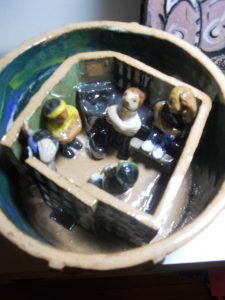 I have heard about art made by inmates (usually called “prison art”) since I started researching outsider art. Some authors include prison art in the broader category of outsider art because it is made by people who are isolated and on the margins of society. I had never seen prison art before yesterday.
I have heard about art made by inmates (usually called “prison art”) since I started researching outsider art. Some authors include prison art in the broader category of outsider art because it is made by people who are isolated and on the margins of society. I had never seen prison art before yesterday.
Yesterday in Chicago, I saw a flyer advertising a sale of folk and outsider art at someone’s home. Great selection and discount prices were promised. So, of course, I had to go. (I have already had to buy another suitcase to accommodate all the books I have bought, so why not…?) I arrived at Lynne’s large apartment and discovered an entire museum-sized collection of artwork she has acquired over the past 40-odd years. It wouldn’t be right to call Lynne a hoarder (at least not now) because the artwork had been carefully arranged, with the help of an assistant, over the past 3 months. The collection was arranged in categories – Mexican retablos hung on the fireplace, folk art carvings lined the top of the bookcase, and paintings, paintings, and more paintings were stacked in piles along the walls. But that’s not all. There were hundreds of vintage Santa statues, hobo art, face jugs, vases, whirligigs, paint-by-number paintings (really???) and, well, you name it and it was somewhere in that apartment.
There were many things I had never seen before. Like, for instance, who knew that boxes could be made from toothpicks or that people collected sequined fruit? And then there was the prison art. There were stacks of drawings and paintings by Ford – apparently a well-known artist in that genre. His work is confidently and loosely drawn – sometimes in black and white, and sometimes with colour splashed in a few areas. Many of his images were of Adam and Eve, snake and apple included.
Another artist creates little circular ceramic containers, with removable lids. The lids are decorated with ceramic tools, guns, etc. When you remove the lid, you can peer down into a little round prison cell, with one or two people, a bed, toilet and sink. At first glance, you might think you were looking at a cozy interior scene of a tiny house. Then you realize how small the space really is. A world within a world within a world.
I asked Lynne how her prison art collection came to be. She said that many years ago she became interested in the genre and she started visiting prisons. Apparently all prisons have art programs and their work is often hung in the prison entrance. She literally walked into prisons, looked at the art, then asked to speak with the art program director. She was able to choose work that she felt had merit and collect other work by those particular inmates. She sold the work privately or though art galleries; the proceeds went directly into the artist’s prison account for their personal use.
Lynne sometimes went into the prisons to speak with the artists directly. She said it was a peculiar experience to be the only woman in a men’s prison, to walk down halls and have metal doors slam shut after her. She stopped doing that after one inmate became irate that she was not taking his work. From hearing Lynne describe her experiences, you could see the enormous amount of respect she has for these artists and her genuine interest in their work. I asked about artwork produced by female inmates because I only saw one painting by Inez Nathaniel Walker. She explained that art programs are normally in institutions where the inmates have long-term sentences, and those are typically men. Women tend to be incarcerated for shorter terms, and they have less access to art programs.

